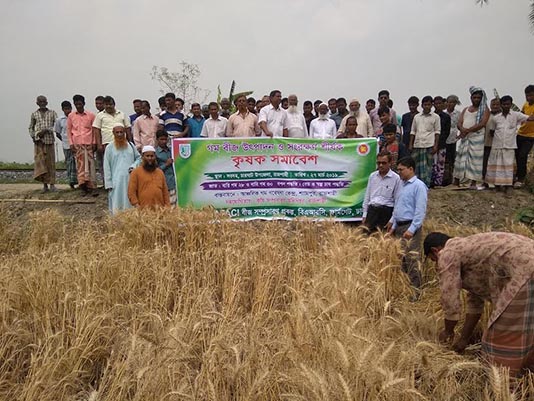RAJSHAHI, April 25, 2019 (BSS) – Farmers have produced around 4.78 lakh
metric tonnes of wheat during the recent harvesting season of the cereal crop
in all eight districts under Rajshahi division.
Quoting the field level reports Dev Dulal Dhali, Additional Director of
Department of Agriculture Extension (DAE), said most of the farmers have
become satisfied with this season’s wheat yield as they cultivated high
yielding varieties developed by Bangladesh Agriculture Research Institute
(BARI).
He said the developed varieties particularly the BARI GOM 28, 30, 32 and
33 are not only resistant to many threats and menaces like drought, blast
like disease and weed but also high yielding. So, the varieties have become
popular among the farmers.
After taking advantages and opportunities given by the DAE and BARI the
farmers are seen increasing the acreage of wheat farming as its demand is
gradually mounting with rising of population.
Agriculturist Dhali says DAE had set a target of producing 4.39 lakh
metric tons of wheat from 1.33 lakh hectares of land. But, amazingly the
farmers brought more than 1.37 lakh hectares of land under the cereal crop
farming that yielded 4.78 lakh metric tonnes of wheat, which is 38,299 metric
tonnes higher than the production target.
Arshad Ali, 52, a farmer of Baduria village under Charghat upazila, has
brought 10 bigha of land under wheat farming this year. He got 18 mounds
yield per bigha on an average.
Side by side with his own farming he provides power tiller operated
machinery services to more than 250 farmers for wheat farming on 400 bigha of
lands and earned Taka 500 from per bigha of land as service charge.
Talking to BSS Ali said use of machinery in wheat farming is gradually
increasing in the region as it contributes to boosting yield.
Sabbir Ahmed, 38, another farmer of Bijoynagar area under Godagari
upazila, said wheat farming is gradually increasing in the area as it’s a
less-irrigation consuming crop.
Dr Ilias Hossain, principal scientific officer of Regional Wheat and
Maize Research Center, said farmers of the Barind area were found more
confident in wheat farming on more new lands, due to the water-stress
condition, as wheat is a less-water consuming plant.
“We have expanded the developed varieties among the farmers through
training, block demonstration and providing inputs in the region,” he said
adding that BARI GOM 33 is a zinc-fortified breed.
The variety has been developed to meet the necessary requirement of
micronutrient for a human body coupled with ensuring food security. It
contained zinc and protein which will ensure high nutrition and will play a
significant role in prevention of diseases.
Muhammad Musha, retired Chief Scientific Officer of BARI, said wide-
range promotion of the newly innovated variety could help increase wheat
yield.
Wheat plays an important role in ensuring food security as its
consumption is increasing day by day. But, Bangladesh produces hardly 10 lakh
metric tonnes of wheat against the demand of around 40 lakh tonnes annually,
he stated.
Agriculturist Musha, however, said that Rajshahi division contributes 35
percent of the total area and 44 percent of the total production. Not only
that, there are around 50,000 hectares of more rain fed land in the high
Barind area and there has been a bright prospect of bringing the huge land
under wheat cultivation.



